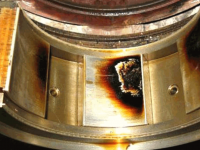Varnish: The Elusive Enigma
Whether tending to a gas turbine or a large hydraulic system, the mere mention of varnish can cause alarm and an immediate call to action.
A number of explanations for the increasing occurrence of lube oil varnish have been postulated. Tighter filtration requirements, higher lube oil flow rates, higher operating temperatures and the switch to Group II base stocks in oil formulations have been offered as potential culprits in the decimation of lube oil systems. Varnish can often lead to unplanned outages and costly downtime, therefore, understanding and responding to varnish with remedial filtration is critical. Unfortunately, the ability to accurately measure varnish potential has remained elusive in routine testing.
Lubricating oil in gas turbines and hydraulic systems is unfortunately subject to the ravages of varnish. It is well-documented that varnish is an insoluble contaminant comprised of oil degradation by-products and sometimes depleted additive molecules. It is generally caused by some type of thermal (heat-related) stress placed on the oil. The debilitating effects of varnish include the loss of operating clearances within machinery and a loss of heat transfer due to thermal insulating. As more operators face the prospect of varnish in their lube oil systems, they are turning to oil analysis labs for answers.
Let's see how much you know about varnish. (answers are provided at the end)
Question 1
What types of plant equipment are most often subject to the damaging effects of varnish?
A. Hydraulics
B. Gearboxes
C. Gas Turbines
D. Both A & B
E. Both A & C
Question 2
Which of the following will detect an oils potential to generate varnish?
A. Elemental Analysis
B. Particle Count
C. Analytical Ferrography
D. All of the Above
E. None of the Above
Question 3
From the list below choose 2 problems often associated with varnish.
A. Increased Moisture Content
B. Increased Friction in Components
C. Restriction or Impedance of Oil Flow
D. Significant Drop in Oil Viscosity
E. Sticking Valves
Question 4
Varnish is comprised of oil degradation by-products. Which of the following would NOT be considered a mechanism contributing to varnish formation?
A. Oxidation
B. Viscosity Shearing
C. Thermal Degradation
D. Micro-Dieseling
Question 5
Once varnish is detected in a lube oil system the recommended course of action is usually a drain, flush and fill.
True or False?
[Answer Key: Click here to get the answers to the varnish quiz.]
About TestOil
With more than 30 years of experience in the oil analysis industry, TestOil focuses exclusively on assisting industrial facilities with reducing maintenance costs and avoiding unexpected downtime through oil analysis program implementation. As industry experts in diagnosing oil-related issues in equipment such as turbines, hydraulics, gearboxes, pumps, compressors and diesel generators, TestOil provides customers with a guarantee of same-day turnaround on all routine testing. With in-house certified training professionals, TestOil offers lubrication and oil analysis training, private onsite training, certification training and exams, and educational webinars. For more information on partnering with TestOil on oil analysis programs or training opportunities visit www.testoil.com. Contact us: 216-251-2510; sales@testoil.com.


